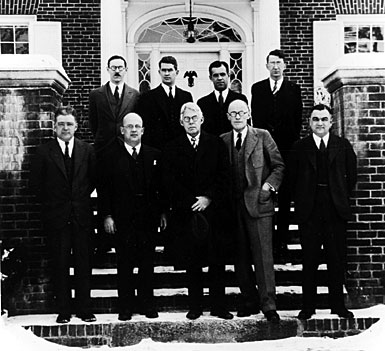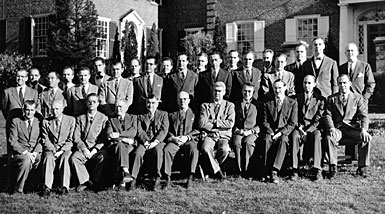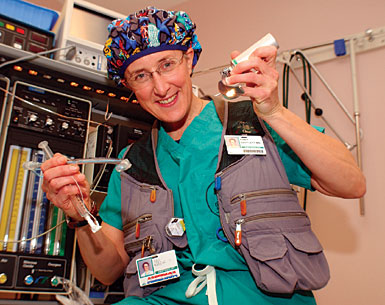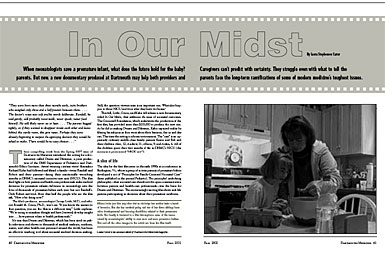Letters From Readers
A pair of historical features about the Hitchcock Clinic in our Winter 2002 issue drew the greatest number of letters in recent months. But stories on several more contemporary matters, ranging from fishing vests to winter footwear to thalidomide—in issues dating back to Summer 2002—also came in for comment.
Retain that historian!
I enjoyed Constance Putnam's fascinating piece (in fact, two fascinating pieces!) in the Winter 2002 Dartmouth Medicine ["A Long-Running Hit," marking the 75th anniversary of the Dartmouth-Hitchcock Clinic, and "Between the Front and Doctor Bowler," about the voluminous correspondence during World War II between alumni in the service and one of the Clinic's founders].
What an enormous amount of research she did—digging, interviewing, and generally gathering more information than I am sure anyone has ever accumulated on the subject. I like her relaxed style; it fits the subject and the magazine and grabs the reader's attention. Very well done. It is great tribute to Dartmouth, too.
Perhaps Dartmouth should appoint Putnam its official historian and put her on a retainer! I hope these articles are getting lots of praise from alumni of the Medical School.
Amalie M. Kass
Lincoln, Mass.
Kass is the president of the Massachusetts Historical Society and the author herself of several medical history biographies. If DMS had an official historian, Putnam would be a fitting candidate for the post, for she is coauthor of the only comprehensive biography of the School's founder (Improve, Perfect & Perpetuate: Dr. Nathan Smith and Early American Medical Education, published by University Press of New England) as well as the author of a forthcoming book on DMS's 200-plus-year history.

|

|
|
These group portraits of members of the Hitchcock Clinic—the top one dating from 1932 and the bottom one from 1947—both inspired letters from readers. |
A matter of principle
I enjoyed both of the historical articles by Constance Putnam in the most recent issue. It is a sign of my old age that I actually knew seven of the nine Clinic members in the 1932 portrait.
It is unfortunate that money matters often interfere with the relationships among doctors. I joined the Exeter, N.H., Clinic directly from my Hitchcock experience precisely because I believed in the equal-earning concept that the Hitchcock Clinic espoused and that was then the method at Exeter. The principle held fast from the Exeter group's postwar beginnings until the 1970s, by which time the group had grown to over 20 (from six when I joined).
With that many new, younger doctors, it is not surprising that different ideas came forth. I never could understand why they joined up in the first place if they didn't share the philosophy. But I began to see the front line cracking. In one acerbic meeting, I was so disillusioned that I said, "Scratch a gentleman with a nickel, and you'll find the bastard underneath"—a quote of which I was often reminded.
In any case, I decided to leave the group before it fractured totally over money. It did, and I am now in North Carolina.
Jerome Nolan, M.D.
DHMC Housestaff '52-54
Wilmington, N.C.
The 1932 photo Nolan refers to is reproduced above. And the "equalearning concept" he mentions was one of the founding principles of the Hitchcock Clinic—that its members would be paid the same, rather than according to a specialty-based scale. As Putnam's article stated, "Remarkably, the principle of equal salaries regardless of specialty lasted until 1979. Even today there are stringent limits on how far apart Clinic salaries are allowed to be. There is not a surgeon at the Dartmouth- Hitchcock Clinic today who could not earn a great deal more elsewhere."
Through a glass clearly
Seen through a magnifying glass clearly, the 1947 photograph of all those Hitchcock Clinic physicians in Dartmouth Medicine's Winter issue evoked a number of memories, because my husband, Elmer, and I moved to Hanover that year. Many of the doctors were contemporaries of ours. We encountered one another not only at appointments or in emergencies, but on the ski slopes, at PTA meetings, and on social occasions.
A few of many recollections come to mind: Dear Rad Tanzer's cheerful, instant, late-evening response to an anxious mother's SOS to come to the ER and suture a hockey-injured son's eyelid (no doubt frustrating the resident eagerly poised to tackle the case). Empathetic John Murtagh's eyes actually brimming over as he declared, "If only you'd come sooner, your eardrum wouldn't be about to rupture"; he truly felt his patients' pain. Our longtime, beloved pediatrician Colin Stewart, keeping us on tenterhooks during house calls with a leisurely discourse on the prognosis of the illness before finally assuring us that the patient was not in mortal danger; along with prescriptions, he dispensed a lot of plain, common-sense suggestions to parents, such as not to panic over a spiking fever, but, "Just yank off those three extra blankets, for heaven's sake!"
My first Clinic visit occurred in 1931, when I was 12 and had been driven "all the way" from Fairlee, Vt., in the Aloha Hive camp truck to have a dislocated knee looked at. Although I was amazed that only canvas curtains, not walls, separated the examination areas, the treatment I received—surely by one or another of the doctors in that photo— was reassuringly kind and equaled what I was used to in the Boston area.
I walked into that same small, red-brick building 16 years later to be signed in before hastening up to the hospital's maternity floor to have the first of our three "Dr. Boardman babies," whose number is legion in the Upper Valley. I imagine most of us lucky enough to have been his patients found his good-natured, relaxed manner as pleasing as I did.
Another event quite unrelated to the 1947 photo, but of possible interest as part of the Clinic's history, took place in the 1970s when the Clinic began running out of space on Desk 200, the general internal medicine floor of Mary Hitchcock Memorial Hospital. To relieve this situation, it was decided that Dr. Gile's former home, directly across the street, should be used solely for patients from Hanover, N.H., and Norwich, Vt. Those of us who qualified basked in the attractive, large waiting and examination rooms and the comparative quiet of Fowler House. Two outstanding diagnosticians, John Milne (our incomparable family doctor for 30 years) and Lou Matthews, plus a pair of equally caring pediatricians, William Boyle and Alan Rozycki, made up the staff there.
Spoiled though we became, we locals accepted and survived the ultimate evolution from those cozy quarters to the huge, regional facility that now exists— because it's clear that the mission of the founding fathers, 75 years ago, to deliver first-class medical care, is ongoing.
Elaine Harp
Hanover, N.H.
The 1947 Clinic photo is the bottom image above.
 We're always glad to
hear from readers
—whether it's a letter
from a longtime subscriber
who's weighing in
with an opinion, or a
note from someone who would like to
become a longtime subscriber. In fact, we are happy to send Dartmouth
Medicine—on a complimentary basis—to anyone who
is interested in the subjects that are covered in the magazine. We
regret, however, that the complimentary subscription offer can be
extended only to addresses in North America. Both subscription
requests and letters to the editor may be sent to: Editor, Dartmouth
Medicine, One Medical Center Drive (HB 7070),
Lebanon, NH 03756, or via e-mail to: dartmed@dartmouth.edu.
Letters for publication may be edited for clarity or length.
We're always glad to
hear from readers
—whether it's a letter
from a longtime subscriber
who's weighing in
with an opinion, or a
note from someone who would like to
become a longtime subscriber. In fact, we are happy to send Dartmouth
Medicine—on a complimentary basis—to anyone who
is interested in the subjects that are covered in the magazine. We
regret, however, that the complimentary subscription offer can be
extended only to addresses in North America. Both subscription
requests and letters to the editor may be sent to: Editor, Dartmouth
Medicine, One Medical Center Drive (HB 7070),
Lebanon, NH 03756, or via e-mail to: dartmed@dartmouth.edu.
Letters for publication may be edited for clarity or length.
A familiar face
I was so pleased to see the picture and write-up in the last Dartmouth Medicine of Dr. Harbaugh. [A professor of neurosurgery at DMS, he was included in the "Media Mentions" section in Winter 2002.]
A few years ago, standing on the beach in Miami, my husband suddenly fell to his knees. Since he was a patient at the White River Junction VA Medical Center, we went to the VA in Miami. They wanted to do surgery right away, but he wouldn't let them. So they made him promise to get to Vermont—the sooner the better and, no, he wouldn't fly. We got home to Berlin, N.H., and the next day were in White River; they had received all the information from Miami, and to Dartmouth- Hitchcock he was taken.
All went well. Then on a Sunday the young interns, I guess, looked my husband over. When they left I said to a nurse, "I think I see a loose wire." She looked and said, "Yes, there is. I'll reach a doctor." It was Dr. Harbaugh's weekend off. Nevertheless, it wasn't long before he was there. So what a joy it was for me to see him again.
Alice Allen
Berlin, N.H.
This is not a tall tale
I have a "fish story" that your readers might find amusing. [The writer of this letter, a DHMC resident in anesthesiology, was the subject of an article in the Summer 2002 issue about her penchant for wearing a fishing vest in the operating room because she finds its many pockets useful for holding all the equipment she needs to carry.]
I was walking along Level 5 at DHMC recently, about to go into Matthews-Fuller Library, when a man stepped out of a phone booth and said, "Hey, I know you. I read about you in a magazine."
I tried to deny it, but he insisted and introduced himself as the president (or maybe it was past president) of the Fly-Fishing Federation. We chatted for a time. It turned out he had been hanging around DHMC for several weeks while his daughter was recovering from an operation, and he was just going home that day. He said he's a registered fly-fishing guide for L.L. Bean, and so we joked about the competing companies, since I wear an Orvis vest.
I later looked up the Fly-Fishing Federation on the Internet, and sure enough he's listed there. Actually, this wasn't the first time I've had to admit to being featured in the magazine. That article has launched me to almost hospital-wide recognition. I wonder what's next. Orvis calendar girl?
Ann S. Bartlett, M.D.
Lebanon, N.H.
Bartlett is actually only half-joking with that last comment. After our story about her vest was published, Dartmouth Medicine received an e-mail from a member of the Orvis staff about the possibility of including Bartlett's tale in one of their catalogs. We (and Bartlett) took the bait but never heard anything more. Bartlett is pictured below in her multipocketed vest.

|

|
|
A resident who's a minor celebrity due to her choice of OR garb (top) and a feature about a DHMC documentary (bottom) are both the subject of letters. |
Captivated audience
We were captivated by the article in the Fall 2002 issue about the video In Our Midst. Where would it be possible to see or borrow that and the other video mentioned in the article, Dreams and Dilemmas? We live in Burlington but come to Lebanon every four months.
I would also like to subscribe to Dartmouth Medicine. We receive many of my son's medical services at the Children's Hospital at Dartmouth and see the magazine there. My son's extensive special needs have made me quite choosy in what I take the time to read—a testament to the quality I found in your pages.
Valerie Wood-Lewis
Burlington, Vt.
These two documentaries, which were produced at DHMC and explore some of the decisions and outcomes associated with prematurity, are available through Fanlight Productions. Details about buying or renting them can be obtained by phone at 800/937-4113; by e-mail at info@fanlight.com; or via the Web at www.fanlight.com. The fees to purchase or even rent the videos are quite high, in part because they come with continuing medical education guides since the target audience is primarily healthcare professionals. But interested individuals may be able to find an institution in their area that would be willing to sponsor a showing.
Fancy that footwear
I am sending a hand-written note rather than a quick e-mail because I get many e-mails at work and home, and most of them are destined for the cyberdelete heap. What prompted a real letter? The wonderful "Editor's Note" on footwear at DMS in the last issue!
That piece brought back many happy memories of my years as a graduate student in the Dartmouth physiology department. Scientific excellence and integrity always came first there. Marsh Tenney set the standard and all followed. No one was unapproachable— faculty, staff, students, and even the reticent New Englander who swept up at night while we worked in the lab. I learned a lot about physiology but also learned the importance of apolitical integrity. Those values have shaped my career and my life.
When I left Hanover for a postdoctoral position (and eventually a faculty position) in Toronto, I suffered the culture shock of leaving the woods that I loved for the trauma of a large metropolitan area. But luckily my mentor and boss in Toronto, A.C. "Charlie" Bryan, knew how to wear sandals in summer and L.L. Bean boots in winter. Charlie and I often laughed about Toronto residents who insisted on slipping and sliding through the winter streets on expensive leather soles.
More importantly, I also found the kind of scientific environment I had grown up in—in Buffalo (working with Hermann Rahn, Leon Fahri) and in Hanover (with Marsh Tenney, Don Bartlett, etc.). We were in it for the science and the advancement of medicine. The politics could be dealt with by using logic, honesty, and solutions that benefit the whole not the individual. First and foremost, we were individuals worthy of respect and of having our opinions heard in an open forum. We may have had disagreements, but they were never dealt with by personal vindictiveness.
I have attempted to maintain this approach with my own students and current colleagues. This is not always easy in an environment where personal success is valued more than fairness and advancement of the whole. Watching your back makes it hard to look ahead. I still wear my sensible shoes and try to promote the DMS "culture."
Thank you for reminding me why it is all worthwhile, with a simple, eloquent analogy that shows us what matters in our professional lives.
Sandra England, Ph.D.
DMS '81
Princeton, N.J.
A case in point
On page 61 of the Fall 2002 issue of Dartmouth Medicine [in an "Alumni Album" profile of Raymond Alexanian, DMS '53], there was a reference to the use of thalidomide in the treatment of multiple myeloma; the article mentions that this was a "startling discovery." Thalidomide certainly is a fascinating drug, which I hear is also being used to treat the debilitating aphthous ulcers in patients with AIDS.
In fact, I published a case report in 1987 (in the journal Oral Surgery, Oral Medicine, and Oral Pathology) in which I described the successful use of thalidomide for a patient with debilitating recurrent aphthous stomatitis of the Behcet's type. I have been retired since 1987, but I am told by the patient's current doctor that he continues to do well.
I am sure that both Dr. Alexanian and his colleague Dr. Barlogie will find word of this patient interesting. Their work with multiple myeloma deserves accolades.
I read Dartmouth Medicine from cover to cover and thank you for sending it to me.
Leon Eisenbud, D.D.S.
Naples, Fla.
Vox clamantis
As a 94-year-old alumnus of Dartmouth College (and secretary of the Class of 1931)—who has recovered from three broken vertebrae and is threatened with prostate cancer—I read each line of Dartmouth Medicine.
I especially enjoyed the latest issue. Peter Dorsen's letter about Professor Royal Nemiah reminded me that when I graduated from the Lawrenceville School, my Latin teacher charged me with making sure I took as many of Professor Nemiah's Latin courses as possible, or else my time at Dartmouth would be wasted. This summer, I met several Dartmouth alumni who regretted not taking Greek.
I would be grateful if you would add my granddaughter to your subscription list; a graduate of Princeton, she has a Ph.D. from Trinity (where she was a Marshall Scholar) and is now vice president of new products at PerkinElmer. She, in turn, will share the magazine with a fellow Trinity alum whose father is the retired head of a medical school in Sydney, Australia.
Thank you.
Victor R. King
Dartmouth College '31
Plainfield, N.J.
Cementing a connection
I was at DHMC today with a friend, and while I waited I read your magazine—as I have done in the past.
I would enjoy receiving it regularly for I, like so many, have a connection with your fine hospital and enjoy your articles about its history.
Karen Mansfield
New London, N.H.
Home delivery?
My daughter has cystic fibrosis so we travel to Dartmouth-Hitchcock Medical Center on a regular basis.
Many times while we are there, I have had occasion to pick up Dartmouth Medicine magazine and browse through it. I have been very impressed by the articles and information it contains. Several times I have come across material that has been both informative and beneficial to my family.
I would like to be added to your mailing list to receive the magazine at home. If this is not possible, I wish to thank you for making copies of it available in the waiting areas throughout the Medical Center. I very much enjoy the chance to get a periodic brief review of your wonderful publication.
Wendy Brundle
Lancaster, N.H.
As explained in the box on page 23, we are happy to add to our mailing list anyone who is interested in the subjects that we cover in Dartmouth Medicine. Note, however, that the complimentary subscription offer can be extended only to addresses in North America. The last letter letter above presents a welcome opportunity to extend public thanks to the dedicated members of the DHMC volunteer corps who distribute the magazine throughout the Medical Center. �
 Be sure to tell us when you
move! If your address
changes and you want to
continue to receive the magazine,
just tear off the back
cover of the most recent issue,
write your new address
next to your old one, and mail it to: Dartmouth Medicine, One
Medical Center Drive (HB 7070), Lebanon, NH 03756. It helps
us greatly—since our mailing list is drawn from seven separate
databases—if you send the actual cover (or a photocopy), rather
than just your new address. Note, too, that if you receive more
than one copy of the magazine, it's because of those seven databases
(which are in different formats, so they can't be automatically
"de-duped"). We're happy to eliminate duplications, but
again it's a great help if we have the address panel from all the
copies you receive, not just the one(s) you'd like deleted.
Be sure to tell us when you
move! If your address
changes and you want to
continue to receive the magazine,
just tear off the back
cover of the most recent issue,
write your new address
next to your old one, and mail it to: Dartmouth Medicine, One
Medical Center Drive (HB 7070), Lebanon, NH 03756. It helps
us greatly—since our mailing list is drawn from seven separate
databases—if you send the actual cover (or a photocopy), rather
than just your new address. Note, too, that if you receive more
than one copy of the magazine, it's because of those seven databases
(which are in different formats, so they can't be automatically
"de-duped"). We're happy to eliminate duplications, but
again it's a great help if we have the address panel from all the
copies you receive, not just the one(s) you'd like deleted.
